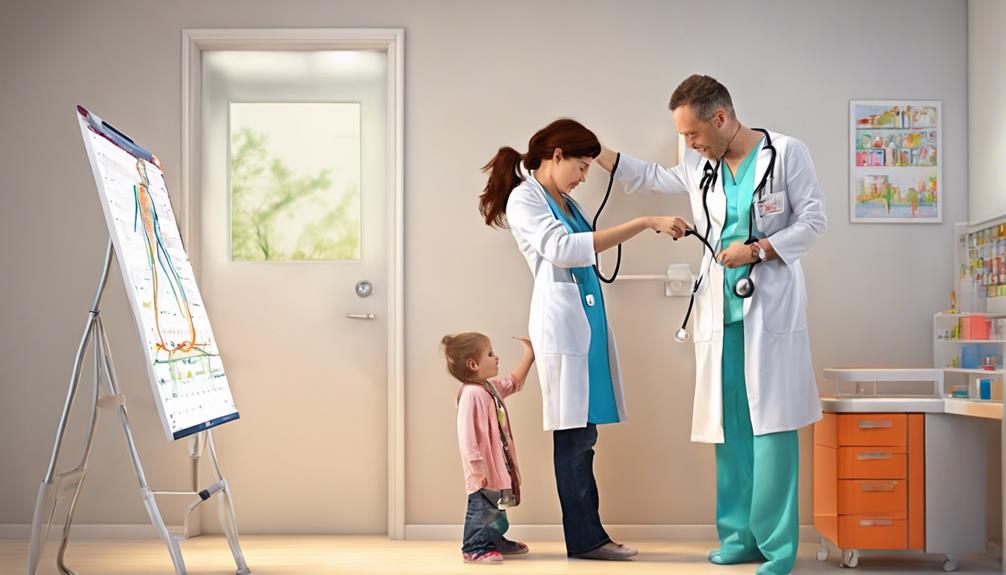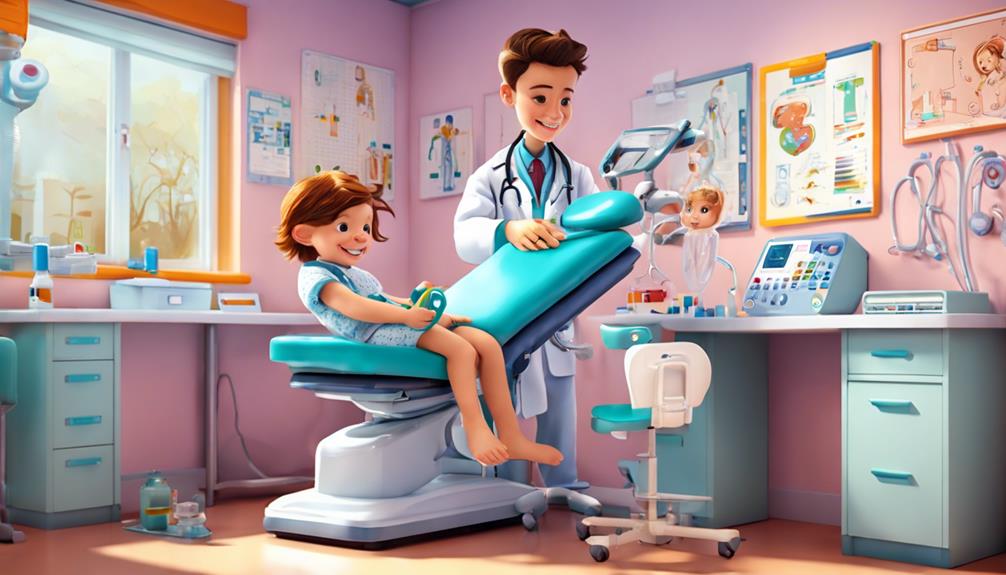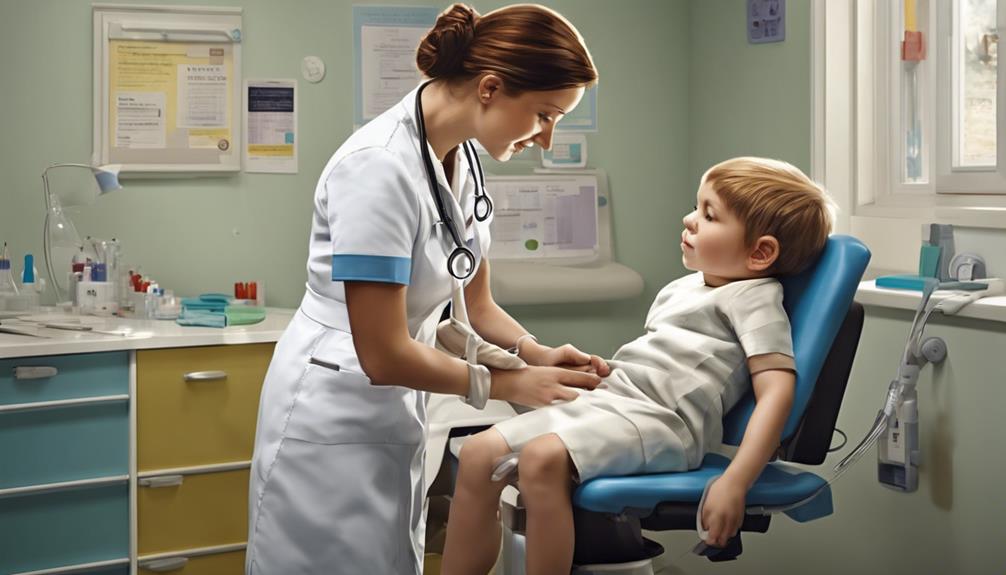Symbolically, the fabric of child health surveillance in Scotland intertwines a comprehensive approach to protecting the well-being of our youngest citizens. From the supportive guidance of Health Visitors to the detailed data collection by Public Health Scotland, each element contributes to a complete perspective of children’s health.
But what lies beneath the surface of this intricate system, and how does it truly impact the lives of Scotland's children? Let's unravel the layers and explore the inner workings of child health surveillance in Scotland, revealing the unseen mechanisms that shape the health outcomes of our future generations.
Key Takeaways
- Thorough monitoring by Health Visitors ensures growth, health, and developmental milestones are met.
- Equitable access to child health checks across socio-economic levels and genders in Scotland.
- Increase in coverage for key reviews like 13-15 month and 4-5 year assessments.
- Emphasis on early intervention, health promotion, and timely identification of issues for children's well-being.
Overview of Child Health Surveillance in Scotland
In Scotland, child health surveillance is a thorough program that monitors the growth, health, and developmental milestones of all preschool children from birth until they enter school, conducted primarily by Health Visitors. These child health reviews play an essential role in ensuring the well-being of our children. It's heartening to note that the coverage levels for key reviews such as the Health Visitor first visit, 6-8 week review, and 27-30 month review have remained consistent over the years.
Furthermore, the recent increase in coverage for the 13-15 month and 4-5 year reviews signifies an enhanced reach and impact of these assessments.
Equitable access to these essential health checks is evident across socio-economic deprivation levels and genders in Scotland, reflecting a commitment to providing every child with the same level of care. Despite the challenges posed by the COVID-19 pandemic, the child health surveillance system has shown remarkable resilience, bouncing back to pre-pandemic levels. This underscores the dedication and adaptability of the healthcare professionals involved in ensuring the health and well-being of our children.
Key Components of Child Health Checks

Covering a wide range of assessments, the key components of child health checks in Scotland encompass evaluations of growth, health, and developmental milestones conducted by dedicated Health Visitors. These reviews play a pivotal role in promoting the well-being of children and enabling early intervention when needed.
- Early Intervention is an important aspect of these health checks, allowing for timely support and assistance for any developmental concerns that may arise.
- Health Promotion is emphasized throughout the assessments, aiming to educate parents and caregivers on best practices for maintaining a child's health and well-being.
- Identification of any issues or delays in growth and development is a primary goal, enabling appropriate steps to be taken promptly to address any challenges and ensure a child's best development.
Through these thorough reviews, Health Visitors in Scotland aim to provide thorough care and support to every child, fostering a nurturing environment for their overall health and development.
Role of Health Visitors in Surveillance

Our role as Health Visitors in child health surveillance entails conducting thorough assessments of growth, health, and development to guarantee the well-being of every child under our care.
We, as Health Visitors, are dedicated to providing thorough Child Health Reviews that encompass meticulous Growth Assessment, Development Assessment, and Health Promotion.
Our focus extends beyond mere assessments; we offer important Parenting Advice and Early Intervention services to support both children and their families.
By actively engaging in these assessments at key stages from birth to school entry, we play a pivotal role in promoting the overall well-being of children in Scotland.
Timely Reviews are essential in our practice, ensuring that no child's health or developmental needs go unnoticed.
Through our continuous support and intervention, we aim to identify any emerging issues promptly and provide the necessary assistance to optimize each child's health and development.
Impact of Child Health Surveillance Programs

Shifting from our role as Health Visitors in conducting thorough child health assessments, the impact of child health surveillance programs in Scotland manifests in the consistent coverage levels achieved for key reviews in recent years. This consistency reflects the dedication to ensuring that children across the country receive essential health checks at important developmental stages.
Equitable Access: Data indicates similar coverage levels across socio-economic deprivation levels and genders, emphasizing the commitment to providing access to child health surveillance programs for all children in Scotland.
COVID-19 Disruptions: The pandemic initially led to disruptions in review delivery, affecting the timeliness of health checks. However, through concerted recovery efforts, coverage levels have been restored to pre-pandemic standards, ensuring that children continue to receive the necessary support for their health and development.
Improved Access: There's been a significant increase in coverage for the 13-15 month and 4-5 year reviews in recent years, indicating improved access to key child health reviews and enhancing the early identification of health issues.
Future Directions for Child Health Surveillance

As we navigate the evolving landscape of child health surveillance in Scotland, enhancing collaboration between health, education, and social services stands as a critical cornerstone for ensuring thorough support for children.
Looking towards future directions, Scotland is focusing on bolstering health promotion efforts to provide parents with essential information on child development and fostering support through local community networks. Additionally, formal screening for hearing and vision will be prioritized, with designated coordinators in each NHS Board overseeing efficient testing and referral processes for children's health monitoring and support.
To drive effective child health surveillance strategies, implementation guidance stresses the importance of appointing leads within NHS Boards. These leads will spearhead program implementation and ensure that surveillance services are delivered optimally across different regions. Furthermore, workforce strategies are honing in on reviewing staff numbers, skills, and distribution to enhance the delivery of child health surveillance services.
Frequently Asked Questions
What Is the Child Health Surveillance Scotland?
Child Health Surveillance in Scotland involves health reviews for preschoolers by Health Visitors. These assessments cover growth, health, and development, aiming to support well-being through health promotion and early intervention services. We guarantee all eligible children receive timely reviews.
What Is Child Surveillance?
Child surveillance is our compass, guiding us through the health landscape of children. We observe, assess, and intervene early, nurturing growth and addressing potential concerns. It's our mission to safeguard every child's well-being.
What Is a Primary 1 Health Check in Scotland?
In Scotland, a Primary 1 Health Check is a thorough assessment offered to children around age 5 as they start Primary 1. These checks focus on evaluating growth, health, and development to detect issues early and provide necessary support.
How Often Does the Health Visitor Come Scotland?
We see Health Visitors in Scotland at key stages like the first visit, 6-8 week review, 13-15 month review, 27-30 month review, and 4-5 year review. Their regular check-ins support child health and development.
Conclusion
In Scotland, child health surveillance is an essential program ensuring all children receive important health reviews. Health Visitors play a pivotal role in evaluating growth and development, promoting health, and providing early intervention services.
By identifying issues early on, these programs support children's well-being and empower parents to actively participate in their child's health journey.
The future of child health surveillance holds promise for continued support and intervention, shaping a healthier generation.









